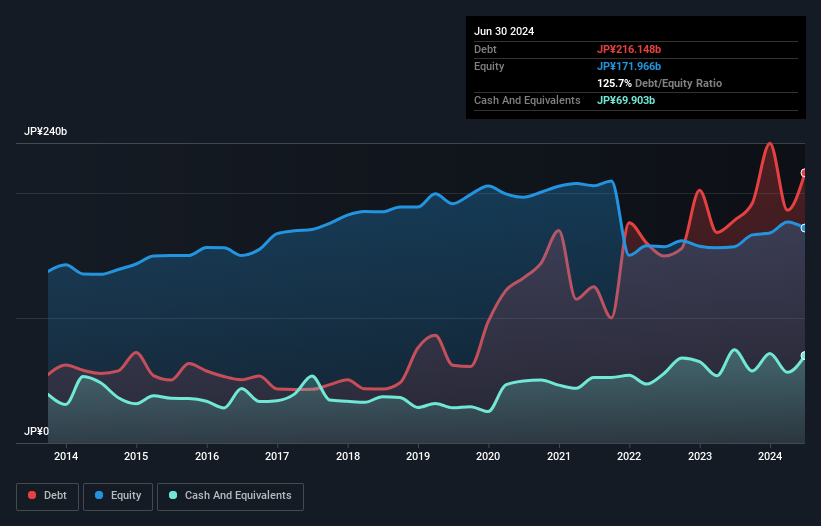
Legendary fund manager Li Lu (who Charlie Munger backed) once said, 'The biggest investment risk is not the volatility of prices, but whether you will suffer a permanent loss of capital.' When we think about how risky a company is, we always like to look at its use of debt, since debt overload can lead to ruin. Importantly, Nishimatsu Construction Co., Ltd. (TSE:1820) does carry debt. But the real question is whether this debt is making the company risky.
When Is Debt A Problem?
Debt is a tool to help businesses grow, but if a business is incapable of paying off its lenders, then it exists at their mercy. In the worst case scenario, a company can go bankrupt if it cannot pay its creditors. However, a more frequent (but still costly) occurrence is where a company must issue shares at bargain-basement prices, permanently diluting shareholders, just to shore up its balance sheet. Of course, plenty of companies use debt to fund growth, without any negative consequences. The first thing to do when considering how much debt a business uses is to look at its cash and debt together.
See our latest analysis for Nishimatsu Construction
What Is Nishimatsu Construction's Debt?
You can click the graphic below for the historical numbers, but it shows that as of June 2024 Nishimatsu Construction had JP¥216.1b of debt, an increase on JP¥178.2b, over one year. However, because it has a cash reserve of JP¥69.9b, its net debt is less, at about JP¥146.2b.

How Strong Is Nishimatsu Construction's Balance Sheet?
Zooming in on the latest balance sheet data, we can see that Nishimatsu Construction had liabilities of JP¥254.1b due within 12 months and liabilities of JP¥137.4b due beyond that. Offsetting this, it had JP¥69.9b in cash and JP¥177.4b in receivables that were due within 12 months. So its liabilities total JP¥144.2b more than the combination of its cash and short-term receivables.
This deficit is considerable relative to its market capitalization of JP¥196.4b, so it does suggest shareholders should keep an eye on Nishimatsu Construction's use of debt. This suggests shareholders would be heavily diluted if the company needed to shore up its balance sheet in a hurry.
In order to size up a company's debt relative to its earnings, we calculate its net debt divided by its earnings before interest, tax, depreciation, and amortization (EBITDA) and its earnings before interest and tax (EBIT) divided by its interest expense (its interest cover). This way, we consider both the absolute quantum of the debt, as well as the interest rates paid on it.
As it happens Nishimatsu Construction has a fairly concerning net debt to EBITDA ratio of 5.6 but very strong interest coverage of 1k. This means that unless the company has access to very cheap debt, that interest expense will likely grow in the future. Notably, Nishimatsu Construction's EBIT launched higher than Elon Musk, gaining a whopping 125% on last year. There's no doubt that we learn most about debt from the balance sheet. But it is future earnings, more than anything, that will determine Nishimatsu Construction's ability to maintain a healthy balance sheet going forward. So if you're focused on the future you can check out this free report showing analyst profit forecasts.
But our final consideration is also important, because a company cannot pay debt with paper profits; it needs cold hard cash. So it's worth checking how much of that EBIT is backed by free cash flow. Looking at the most recent three years, Nishimatsu Construction recorded free cash flow of 30% of its EBIT, which is weaker than we'd expect. That's not great, when it comes to paying down debt.
Our View
Nishimatsu Construction's interest cover was a real positive on this analysis, as was its EBIT growth rate. But truth be told its net debt to EBITDA had us nibbling our nails. When we consider all the factors mentioned above, we do feel a bit cautious about Nishimatsu Construction's use of debt. While debt does have its upside in higher potential returns, we think shareholders should definitely consider how debt levels might make the stock more risky. There's no doubt that we learn most about debt from the balance sheet. But ultimately, every company can contain risks that exist outside of the balance sheet. For instance, we've identified 2 warning signs for Nishimatsu Construction (1 shouldn't be ignored) you should be aware of.
At the end of the day, it's often better to focus on companies that are free from net debt. You can access our special list of such companies (all with a track record of profit growth). It's free.
Valuation is complex, but we're here to simplify it.
Discover if Nishimatsu Construction might be undervalued or overvalued with our detailed analysis, featuring fair value estimates, potential risks, dividends, insider trades, and its financial condition.
Access Free AnalysisHave feedback on this article? Concerned about the content? Get in touch with us directly. Alternatively, email editorial-team (at) simplywallst.com.
This article by Simply Wall St is general in nature. We provide commentary based on historical data and analyst forecasts only using an unbiased methodology and our articles are not intended to be financial advice. It does not constitute a recommendation to buy or sell any stock, and does not take account of your objectives, or your financial situation. We aim to bring you long-term focused analysis driven by fundamental data. Note that our analysis may not factor in the latest price-sensitive company announcements or qualitative material. Simply Wall St has no position in any stocks mentioned.
About TSE:1820
Nishimatsu Construction
Engages in the construction, development, real estate, and other businesses in Japan and internationally.
Average dividend payer with moderate growth potential.
Market Insights
Community Narratives



